Abstract
Translating scientific findings into concrete action for (ground)water protection should be fundamental component of any hydrogeological and hydrogeochemical assessment, thus ensuring that scientific outcomes have a positive impact in the real world. To this purpose, understanding the water-related issues and the perceived criticalities by the water users is an asset, especially for earth scientists who are often the first contact with local communities during in situ measurements. By presenting the results of a socio-hydrogeological assessment in the Inle Lake area, this paper aims at demonstrating the feasibility and added value of this approach. In conjunction with groundwater sampling, public engagement activities were conducted by administering semi-structured interviews at a household level in each monitoring site. Hydrogeochemical data show that groundwater is characterized by an elevated hardness and by the presence of trace metals in solution due to the low redox potential. The work provides suggestions on how to translate the hydrogeochemical information associated to (i) the impact of climate change on water supply and availability, and (ii) the presence of geogenic groundwater contamination (Fe, Mn, As) into accessible information for local communities and water users’ associations. Sharing knowledge and promoting capacity building would also help to assess the reasons for the discrepancy between self-reported perception of groundwater quality (e.g., hardness) and analytical results.
1. Introduction
Water resources management roots its effectiveness in sound scientific knowledge and its translation into concrete decisions (and actions) targeting environmental sustainability, social equity, and economic efficiency. In recent years, increasing attention has been paid to the promotion of Integrated Water Resource Management (IWRM) plans at global level, although most countries (approximately 60%) are still far from a full implementation, with limited arrangements uptake and stakeholder engagement [1]. Consequently, the risk of not achieving SDG6 (Sustainable Development Goal 6: to ensure access to water and sanitation for all [2]) by 2030 is still high in many parts of the world, with several countries reporting no programs to promote efficient water use [1].
Access to safe water resources is tightly linked to equity and justice, and this has been recently evidenced with the Human Rights-Based Approach to IWRM, that sees human rights, development and governance not only as interlinked, but also mutually reinforcing. This additional lens provides a good opportunity to simplify water governance both in the sphere of environmental sustainability and human development [3]. This is particularly crucial not only in countries where physical water scarcity exacerbates conflicts related to competing interests in water access and use, but also in those where, despite the presence of abundant resources, the portion of population without access to safe water and sanitation is still high.
This is the case of Myanmar, a country, where 10 million people (i.e., 18% of the national population) do not have clean water and 11 million lack access to adequate sanitation facilities [4]. In addition, approximately 70 percent of the national population lives in rural areas and farming is the dominant economic activity. With agriculture being mainly rain-fed, the population is strongly dependent on the unevenly distributed rainfall, and thus is greatly exposed to harm related to floods, flash floods, water shortages, and droughts [5].
According to recent estimates, in Myanmar, the degree of implementation of IWRM (SDG indicator 6.5.1.) is only 27%, with relatively low institutional participation and enabling environment [6]. Additionally, the same source reports the existence of procedures defined in law or policy for participation of local communities in water and sanitation planning: the level of participation by users/communities is still low, despite the increase of interest among the stakeholder in the water sector [7,8,9,10,11,12,13]. Consequently, if on the one hand there is a clear need to further promote participatory and trans-disciplinary water quality and quantity assessments, on the other, it is crucial to foster the translation of scientific knowledge into management plans, and to engage the local stakeholders in long-term water resources protection. The latter means to effectively contribute to bridge the gap between science and society, as per the overall goal of socio-hydrogeology [14,15].
To this end, this paper aims at discussing how to effectively translate the scientific outcomes of a five-years surface and ground water quality assessment in the Inle Lake catchment into accessible information for local communities and water users’ associations. The latter is a region of particular cultural, economic, and environmental relevance, where the population has to face increasing competition on water resource use with tourism, and where the qualitative and quantitative status of surface and groundwater is not fully assessed yet. For its important role for both local and national economic development, this area recently became object of several research projects, most of which carried out in the frame of the international cooperation [16], including a pilot IWRM project [5]. However, in most cases, including the latter, no reference to groundwater is made, thus excluding a crucial component from the assessment, despite it being explicitly mentioned in the Myanmar Water Framework Directive (MWFD). Although a critical analysis of the National Water Law is beyond the scope of this manuscript, this evidences that there is a clear need to improve the visibility and understanding of groundwater role in sustaining human and ecological wellbeing, and to foster the participation of water users to support local groundwater governance.
2. Materials and Method
2.1. Study Area
Inle Lake (Southern Shan State) is the second largest lake of Myanmar (with a 17.5 km and width of 5 km), that in recent years is becoming an important tourism attraction, famous for its floating villages and gardens, and where local communities live and economic activities are mainly based on the lake ecosystem services. However, recent studies demonstrated that the lake is experiencing a severe reduction of its open surface [17], a process that can have a dramatic impact on the water and food security of the local populations.
The watershed is a large and flat depression, North to South oriented, and delimited to the East and West by the scarps of the Shan Plateau mountains [18], mostly constituted Cambrian–Ordovician limestones and siltstones, unconformably overlain by thick Permo-Triassic limestones and dolomites [19,20]. The lake has an irregular elongated shape due to its tectonic origin. It is mainly fed from the N by the Nanlit stream and from the W by the Kalaw and Indein streams. The sediment transport and the development of large alluvial fans are conditioned by the tectonic activity [21] and, more recently, by the increased soil erosion due to deforestation [22,23]. The lake outlet is located in the S, carrying waters to the Thanlwin river [24].
The climate in the lake area is classified as Csa following the Koppen–Geiger system [25], with a hot and dry summer (March to June), a rainy season (July to October) and a winter season (November to February). The lake water depth follows the seasonal wet and dry periods, ranging approximately from 1 m in April to 2.5 m in October [17]. In addition, during the rainy season some areas, mostly located to the N and to the W of the lake, are flooded. Therefore, the lake water volume varies from about 50 × 106 m3 in May to 122.6 × 106 m3 in October [17]. Water isotope studies evidenced that through-flow conditions from N to S govern the hydrodynamics of lake and that the water residence time is shorter than one year [26,27]. The short turnover prevents the accumulation of pollutants in the water, but makes the lake very sensitive to climatic changes. Moreover, Re et al. [28] evidenced that the evaporative loss of lake water is low (about 15%) and that groundwater contributes to the lake recharge.
The dominant soil types in the watershed are tropical red soils (Acrisols) at higher elevations, Histosols at lower elevations and paddy soils (Hydragric Anthrosols) in the seasonally flooded areas [22,23,29], where subsistence farming is practiced. However, the main agricultural activity of the Inle lake area is tomato cultivation in floating gardens, where farmers use fertilizers and pesticides, raising concerns about lake water contamination [24].
For a more detailed description of the geological, hydrological and hydrogeological features of the watershed, please refer to [29,30].
The abundance of surface water in the region implies that local population prefers its use to support domestic and agricultural needs over groundwater. This is reflected by the scarcity of wells in the proximity of the Inle Lake. Nevertheless groundwater is increasingly being used, despite the need for more reliable information on the overall groundwater quality status [31]. Additionally, given the vulnerability of surface water to climate change, local populations will have to rely more on groundwater or on alternative sources (e.g., rainwater harvesting) in the near future.
Another impacting factor to be considered is the increasing water demand to sustain tourism development, in a region where tourists exceed the number of local inhabitants: the local population at Inle Lake is around 150,000 inhabitants while approximately 250,000 international and 400,000 local tourists visits the lake annually (before the 2019 pandemic outbreak; [13,32]). The region had a very minimal hotel infrastructure in the early 1990s, and the number increased from 1 to approximately 80 between 1992 and 2016 [33], and now 110 hotels at Inle Lake region are licensed by Ministry of Hotels & Tourism, and 30 guest house at Nyaung Shwe are licensed by General Administration Department (GAD) [34]. This clearly has an impact not only on water allocation (with competing issues with the domestic supply), but also on water quality, as the lack of adequate sanitation infrastructures may lead to a possible increase in nutrient load to the lake and groundwater.
2.2. Hydrogeochemical Assessment
In the present work, hydrochemical and isotopic results of different monitoring campaigns performed in the Inle Lake catchment between 2013 and 2015 [26,28,29,30,35,36,37] are compared with unpublished data collected in February 2018 (Table S1). In this campaign, both surface (lake: 12 samples; rivers: 4 samples; ponds: 2 samples) and groundwater (16 samples) where collected, covering the whole catchment area (Figure 1), in agreement with the monitoring plan established by [26,28].
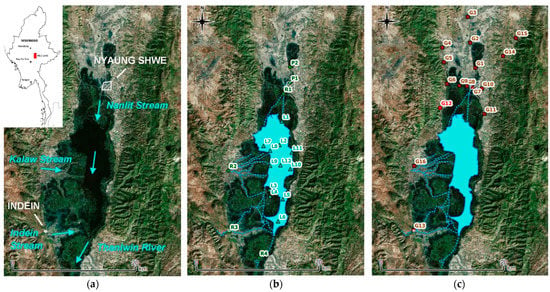
Figure 1.
Study area. (a) Location of Inle lake in Myanmar and main geographical features. Blue arrows indicate surface water flow directions; (b) Location of the sampling points in the lake (triangles, L samples), and in rivers and ponds (circles, R samples); (c) Location of the sampling points for groundwater and the Khaung Daing hot spring (squares, G samples).
In the field, temperature, electrical conductivity (EC), pH, and Eh were measured using a multi-parameter probe (WTW 340i, Wissenschaftlich-Technische Werkstätten GmbH, Weilheim, Germany), and alkalinity was determined with the HACH Alkalinity Test Kit, Model AL-AP. Samples for major elements determinations were collected in pre-washed polyethylene bottles, while samples for trace elements analyses were pre-filtered at 0.45 µm and acidified at pH = 2 with ultrapure HCl. In the laboratory at the University of Torino (Italy), all samples were reanalyzed for EC, pH and alkalinity by titration (Gran titration method) with a Metrohm Titrino basic. The ionic contents were determined by chromatography with a Metrohm 883 basic IC plus (Erisau, Switzerland), equipped with a 20 mL loop and a Metrosep A Supp5 250/4.0 column for anion analysis and a Metrosep C4 250/4.0 column for cation analysis. An unfiltered sample aliquot was subject to persulphate microwave digestion to convert all P in orthophosphate [38], and the total P content was determined with the Molybdenum blue method [39] using the spectrophotometer HACH DR 8200 (Loveland, CO, USA) (wavelength 880 nm, cells of 20 mm light path). Fe, Mn, and As were measured at the University of Pavia (Italy) by Graphite Furnace Atomic Adsorption Spectrophotometry using a Perkin Elmer AAnalist 600 (Waltham, MA, USA). Stable isotopes of the water molecule were determined by Wavelength-Scanned Cavity Ring-Down Spectroscopy (WS-CRDS) at the ISO4 private laboratory (Torino, Italy). Results are reported in the usual delta (δ) notation vs. VSMOW, with an uncertainty (2σ) of ±0.2‰ for δ18O and ±1‰ for δ2H. Descriptive statistics and correlations were calculated using the Microsoft Excel embedded functions. The freeware Diagrammes [40] and QGIS [41] were used for hydrochemical plots and maps, respectively.
2.3. Public Engagement
In conjunction with groundwater sampling, public engagement activities were conducted, by administering semi-structured interviews at household level in each monitoring site. Interviews, conducted on voluntary base and upon signature of an informed consent form, where administered in Burmese.
In the questionnaire, closed-ended, multiple choice, Likert-scale, and ranking style questions were favored to ensure survey brevity and collect a homogeneous and comparable dataset. Open-ended options were also adopted to assess respondent’s experiences or attitudes towards some aspects requiring more detailed discussion (e.g., reaction to specific contamination episodes, perception of climate change issues and willingness to participate in long term monitoring plans). The latter were included to favor the engagement and direct confrontation with local water users, a central component of the socio-hydrogeological approach [14]. The survey was delineated into five distinct sections (water use, groundwater well features, agricultural practices, awareness of water issues and potential for participation; Figure 2). The full questionnaire is provided in the Supplementary Materials.
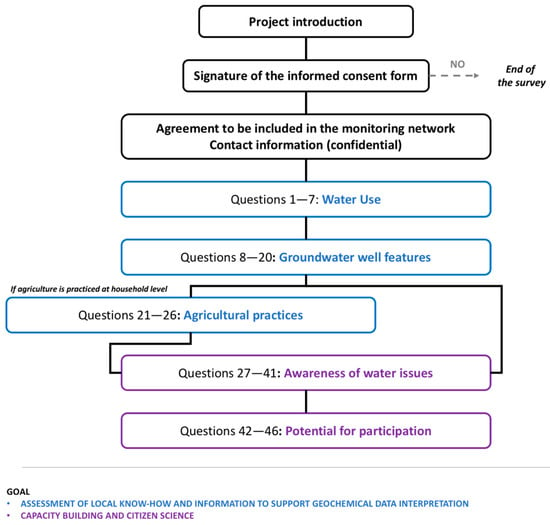
Figure 2.
Survey scheme and sectioning. All questions and answer options are reported in the Supplementary Materials.
In the area, the paucity of private wells is due to the relative abundance of surface water (in the floodable area nearby the lake) and the drilling costs for the creation of new wells in the upper part of the watershed. For this reason, half of the sampling sites are private wells, and the others are either monastery wells (used for water supply by the monks and nearby communities) or village wells.
3. Results
3.1. Surface and Groundwater Quality
3.1.1. Major Ions
Results of the 2018 sampling campaign (Table S1) indicate that bicarbonate is the dominant anion in both surface and groundwater, whereas the cation abundance is more variable. Comparing the data with those available from previous investigation (Figure 3), the following conclusions can be drawn:
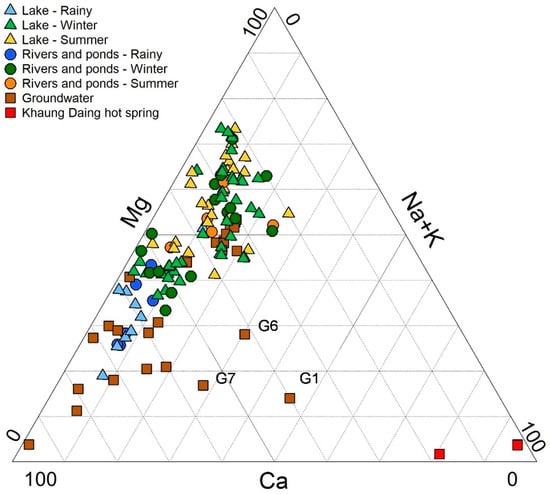
Figure 3.
Relative cation abundance in surface and groundwater.
- Surface waters are dominantly of Ca(Mg) type in the rainy season, and shift to Mg(Ca) type in winter and in summer.
- Groundwater is mostly of Ca or Ca(Mg) type. However, some samples (G6, G7, and G1) show an increased amount of Na + K that exceeds 25%.
- The Khaung Daing hot spring (G12) is instead of Na + K type.
The seasonal shift in composition observed in surface waters was already identified and attributed to calcite precipitation, triggered by the increase in temperature and in photosynthetic activity [26,28,30]. Concerning groundwater, both the sampling campaigns were conducted in winter, at the beginning (December 2015) and at the end of the season (February 2018). In the first campaign, a strong similarity of groundwater to surface water was observed, supporting the assumption that recharge mostly occurred in the seasonally flooded area North of the lake by direct infiltration during the rainy season [28]. In the second campaign, some samples (G7, G8, and G10) showed relatively elevated Cl− concentrations (Table S1), pointing to the presence of a deeper circulation related to tectonic discontinuities, as suggested by Re et al. [28]. Finally, the Khaung Daing hot spring with its elevated temperature, high EC and different water type, is representative of a medium-low enthalpy geothermal source [35,42].
3.1.2. Nutrients
In the February 2018 sampling campaign, nitrates are very low in surface (average 0.53 mg/L) and groundwater (average 3.5 mg/L), with only two groundwater samples with high Eh values exceeding 10 mg/L. The P averages are very similar between surface (17.5 µ/L) and groundwater (14.4 µ/L). However, G9 and the Khaung Daing hot spring show concentrations higher than 50 µ/L. Both nitrates and P concentrations are comparable with those recorded in other sampling campaigns (Table S1) and do not seem to show seasonal fluctuations (although P concentrations were only measured in winter).
These low nutrient concentrations reflect both the relatively low impact of anthropogenic activities and the high resilience of the water resources. Indeed, the alkaline character of surface waters contributes to limit the P concentrations through calcite precipitation and transfer to the sediments. This scavenging mechanism is clearly evidenced in those areas where the anthropogenic input is high, such as the floating gardens or the main lake inlet, where P and nitrates concentrations are higher in waters and, for the former, higher also in the sediments [29]. The low P concentrations and the high N/P molar ratios measured in both surface (average 237, minimum 4, maximum 844) and groundwater (average 8585, minimum 8, maximum 48,953) suggest that phosphorus could be the limiting nutrient in this ecosystem [28].
3.1.3. Trace Metals
Iron, manganese, and arsenic were analyzed in groundwater (including the Khaung Daing hot spring G12) collected in February 2018. Due to the relatively low redox potential, especially in the northern part of the watershed, trace metals are high, with average concentrations of 304, 275, and 21 µg/L for Fe, Mn, and As, respectively (Figure 4; Table S1). Numerous samples (3, 9, and 5 Fe, Mn, and As, respectively) exceed the water quality standards for drinking water [43]. The trace metal contents are not significantly correlated with each other, nor with any other chemical parameter, with the exception of Fe that is inversely correlated to Eh (excluding G12 n = 15; r = −0.68; p < 0.001). This suggests that different sources or processes are responsible for their presence in groundwater. Of particular concern are sample G9 and G12 (the hot spring) with As contents exceeding 100 µg/L. Since the hot spring is used by locals for bathing and by tourists in the nearby spa, potential adverse health effects could arise in the population and the spa workers exposed by dermal contact [42]. The presence of trace metals is also known to affect the quality of Inle lake sediments, representing a risk for the population and the environment [30].
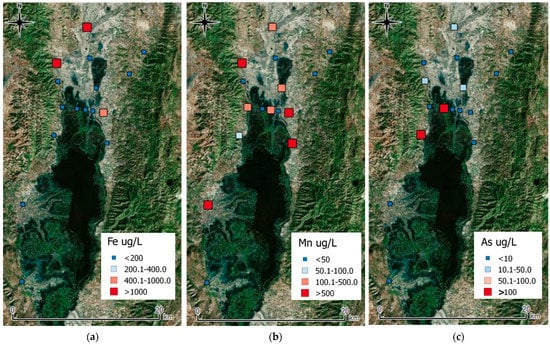
Figure 4.
Distribution of trace metals in groundwater from the Inle lake watershed. (a) iron; (b) manganese; (c) arsenic. Only samples indicated with blue squares have concentrations within drinking water standards.
3.2. Hydrodynamics
The isotopic composition of surface and groundwater sampled in February 2018 is relatively homogenous, with an average and standard deviation of −5.62 ± 0.5 and −46.6 ± 2.15 in surface waters and −6.84 ± 0.84 and −49.3 ± 4.4 in groundwater (including the hot spring) for δ18O and δ2H, respectively.
To compare the data with the isotopic variability in surface waters, three lake sites were repeatedly sampled during the considered monitoring years and in the different seasons (L1, located at the lake entrance, L2 in the wide area and L4 in the floating gardens; Figure 1, Table S1), together with the main inflow (Nanlit stream R1) and the outflow (Thanlwin River R4). The average and standard deviation of the isotopic compositions in the different seasons are shown in Table 1, and all the available data are displayed in Figure 4.

Table 1.
Average and standard deviation of the isotopic composition and of the d-excess of surface water in the different seasons.
In the rainy season, lake waters plot below the Global Meteoric Water Line (GMWL, [44]), but on the regression line for Yangon precipitations (YMWL [45], Figure 5). A progressive increase of the isotopic composition is observed in winter and in summer due to evaporation, as indicated by the samples aligned on a lower slope and by the d-excess [26,27,46]. It is interesting to note that even water from the Nanlit stream as well as the closest lake station L1 are strongly enriched in summer, but still plotting on the YMWL. On the other hand, the regression calculated using the isotopic values of the summer samples crosses the YMWL in correspondence of the average isotopic composition of groundwater. This could indicate that, in addition to precipitation and river water, also the aquifer contributes to the lake recharge, as already pointed out by Re et al. [28], based on hydrochemistry.
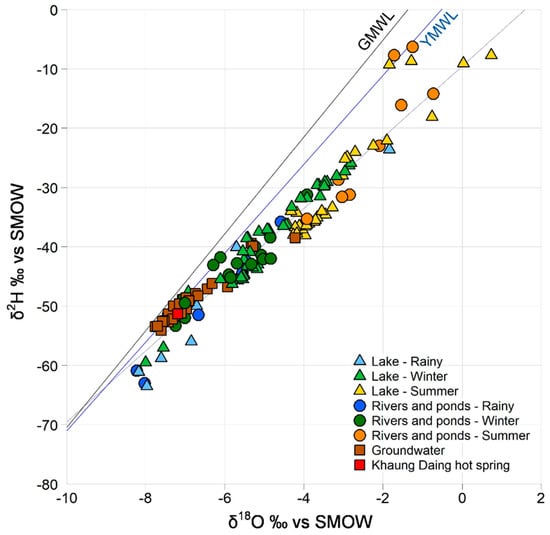
Figure 5.
Seasonal variation of the isotopic composition of lake waters, compared to the Global Meteoric Water Line (GMWL, [44]) and Yangon precipitation waters (YMWL, [45]).
Moreover, in the middle of winter (December 2015), waters from the lake center still show signs of evaporation [28], whereas at the end of winter (February 2018) lake waters are rather homogeneous in isotopic composition (Table S1). This indicates that, during winter, lake waters are fully replaced and therefore the residence time is lower than one year. This observation, coupled to an absence of stratification [28], suggests that the hydrological behavior of the lake is similar to that of a large river.
Concerning groundwater, samples collected in December 2015 (middle of winter) have an isotopic composition very similar to that measured in February 2018 (end of winter), with an average and standard deviation of −6.99 ± 0.68‰ and −49.5 ± 3.9‰ for δ18O and δ2H, respectively. The similar isotopic composition of surface and groundwater during the rainy season supports the findings of the hydrochemical investigation, confirming that the aquifer recharge mostly occurs in the seasonally flooded area North of the lake by direct infiltration. Local recharge is also evoked for the Khaung Daing hot spring, as already discussed by [35].
3.3. Assesment of Local Know-How and Public Participation Potential
The interviews were conducted in 13 of the 16 sites included in the groundwater monitoring network. In three sites, in fact no one was found available for interviews at the time of sampling. Out of the total sample interviewed, 10 (77%) were male and 3 (23%) females, with an average age of 49 years (minimum 37 and maximum 63 years). Among them, 10 (77%) were the owners of (or the person in charge for managing) the sampled wells; mostly monks (5; 38%) and traders (3; 23%), with a quite diverse educational background (ranging from Grade 4 (n = 4) to BSc (n = 1)). As concerns the main freshwater sources for domestic purposes (cleaning and washing) groundwater is used in all the sites (100%), in some cases in conjunction with surface and rainwater (Figure 6). Also for drinking purposes respondents resort to multiple sources, with bottled water and rainwater harvesting (54% and 8% respectively) used together with groundwater (69%). None of the participants indicated using public supply/tap water for any purpose.
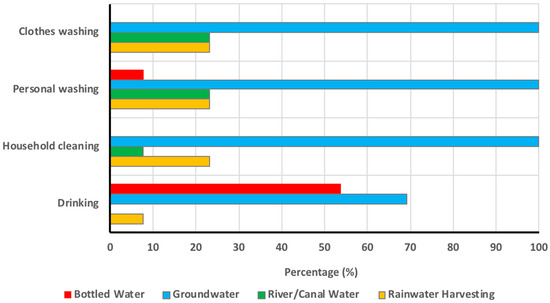
Figure 6.
Main sources (%) of fresh water for domestic and drinking water use in the study area, based on the answers of the interviewees. In the questionnaire, multiple answers were allowed.
In 7 out of 13 sites, water is also used for irrigation purposes (either in case of farming activities for commercial purposes or for private production). In these cases, multiple source irrigation is adopted, with a prevailing use of river/canal water (5 sites; 71%), followed by groundwater (n = 3; 43%) and rainwater (n = 1; 14%). Among the interviewed well owners only 3 declared to have animals for domestic consumption (pigs and cows), and to mainly use well water for animal husbandry. Most of the respondents (n = 10; 77%) know the pumping rates of their wells, that range from 50 to 500 gallons per day (189 to 1890 L/day), with an average of 178 gallons/day (674 L/day).
As concerns sanitation facilities, of all households in which interviews were administered 11 (85%) are equipped with improved sanitation facilities: 8 (73%) pour-flush latrines, 2 (18%) pit latrine with slab and 1 (9%) ventilated improved pit latrine (VIP). In all (100%) cases groundwater is the main water source used in these facilities.
4. Discussion
4.1. Emerging Criticalities from a Scientific Perspective
Since several years, scientists have raised concerns on the decline of the open water surface of the lake [17,47], and on the dramatic drops in the water level observed in summer [48]. These effects are attributed to the agricultural practice of the floating gardens [24], and to deforestation of the watershed [22,23,49,50], leading to accelerated soil erosion and increased sedimentation [30]. Moreover, Re et al. [28] evidenced the interactions between surface and groundwater, and discussed the possible scenarios and positive feedback mechanisms associated to the decrease in lake water volume, especially in relationship with the increased water demand to sustain the economic development of the region. However, all these findings need to be framed in the context of the expected climate changes to evaluate the possible impacts on both water quantity and quality at the watershed scale.
Climate change scenarios indicate for Myanmar an increase in temperature of 1.9–4.1 °C coupled to an increase in precipitation of 9.5–21.1% during the 21st century, depending on the model and the scenarios adopted [51]. Moreover, a change in the precipitation patterns is expected in the near future (<2040), with wet months (July to October) receiving more rainfall and dry months receiving less. As a consequence, during the rainy season, discharge will increase, but decrease in winter. Extreme discharge events are expected to increase in frequency and magnitude [52], leading to a substantial increase in streamflow, soil erosion and sediment transport [53]. Notably, based on the Global Climate Risk Index (CRI) [54] Myanmar was already identified as the world’s second most affected country, due to extreme weather events occurred in the period 1995–2014.
In the Inle lake watershed, climate change will likely result, during the rainy season, in inundations of riverine settlements, sediment deposition in rivers and canals and eventually in the lake, and damage to social and economic infrastructure as well as agricultural lands. By contrast, in winter and summer, the lake water level will likely drop even more, causing problems with navigation and impacting on both tourism and agriculture. The increased water demand expected in these seasons could be satisfied by an increased use of groundwater for domestic and irrigation purposes. However, as already demonstrated ([28] and this work), groundwater contributes to the lake recharge and the lowering of the water table could further aggravate the situation.
Concerning lake water quality, the alkaline character favours the transfer of P and the immobilisation of trace metals in the sediments, while the fast turnover prevents the accumulation of soluble contaminants. These characteristics will likely not be affected by climate change. However, the anthropogenic pressure due to the population growth and the expansion of tourist traffic will not only increase the water demand, but also the pollutant loads. An increase in the organic matter input to the lake has already been evidenced [55], likely associated to soil erosion and to the lack of adequate sanitation facilities. This is of particular concern, as the organic matter degradation may lead to the establishment of anoxic conditions at depth, possibly leading to the re-mobilization of both the P and the trace metals stored in the sediments [30,56]. Moreover, most private houses and tourist resorts do not appear to have adequate wastewater treatment systems [13,57] and water hardness requires an high amount of detergents for laundry and cleaning purposes [58]. A decrease in the lake water volume, even at a constant nutrient and contaminant inputs, will necessarily result in increased concentrations and the consequent deterioration of the water body.
Finally, groundwater quality is characterized by an elevated hardness and by the presence of trace metals in solution due to the low redox potential. Several studies have evidenced the positive health effects of hard drinking water, as it contributes to total intakes of calcium and magnesium [59], and limits the toxicity of numerous trace metals [60]. However, the domestic use of hard water is impaired by the precipitation of scale deposits, that can reduce the life of home appliances (especially those that heat the water) and clog pipes [61]. To remove these deposits, acids are used which are then transferred to wastewater, with negative impacts on the environment. While water hardness is not a concern for irrigation use, industrial uses have very variable maximum accepted values for raw water [60]. The seasonal variability of groundwater chemistry in the study area could not be evaluated, as both the sampling campaigns were conducted in winter; therefore, it is difficult to speculate on the effects of climate change on groundwater quality. On the other hand, concern is raised about the possible health effects related to the population exposure to toxic metals. A country-scale study indicated the widespread occurrence trace metals, particularly As, in Myanmar groundwater, and attributed it to the reductive dissolution of Fe and Mn oxi-hydroxides [62], in line with that indicated by [42] for the Khaung Daing hot spring. However, more research is needed to constrain the origin and the controlling mechanisms of trace metals in groundwater from the Inle lake watershed before considering further exploitation of this resource.
4.2. Public Engagement
All respondents manifested a high level of interest in the project activities and in being engaged in collaborating by answering to the interviews. The failure to administer the questionnaire at three sites is due to the absence of a responsible person at the time of the interview. In one case, the owner of the site, who authorized the sampling, could not be present and the employees said they did not have enough knowledge to answer the questions. In the other two cases, two public wells, nobody was present at the moment of the field work. For a preliminary assessment of the potential of public engagement in the region, the level of involvement is satisfactory, also considering that it was a first project in the area focused on groundwater quality assessment. The lack of a pre-existing monitoring network prevented preliminary contact with the well owners/water managers in order to ensure their presence at the time of on-site measurements. In the future, to maximize the potential of the socio-hydrogeological approach, it will be necessary to plan a first screening and then organize the sampling campaign not only on the basis of logistics, but also on the availability of the wells’ owners/managers.
At the time of the sampling, however, the interest of the research team in local water resources and the wellbeing of the communities relying upon them was welcomed and the bases for possible participatory monitoring were set. Increasing the monitoring network, to identify more functioning wells and consequently increase the samples size for questionnaire administration, will be key to have a broader and more comprehensive understanding of water quality and quantity issues. In addition, the collection of sex-disaggregated data [63] will be performed to evaluate and track the crucial role of women in water use and protection. Clearly, a broader socio-economic assessment, involving a statistically significant sample of the population living in the study area, and therefore using water resources, would allow to obtain more complete information. However, the effectiveness of socio-hydrogeology lies precisely in ensuring direct engagement of the people involved (generally only indirectly) in the monitoring network. Their participation is fundamental, not only to get to assess the local know-how (and use it to support hydrogeochemical interpretations [64]), but above all to avoid the frustration of not being considered as an active part in a process that directly affects them, their territory and their resources.
4.3. Percieved Criticalities by Locals and Geochemical Evidences
Although groundwater is mainly being used for domestic purposes (cleaning and washing), the fact that locals are starting to preferably use bottled water for drinking purposes could be a symptom of a perceived deterioration in the quality of the groundwater itself. One question of the survey was targeted to address the perception of water quality issues (i.e., Are you confronted with periods with bad water quality?). Six of them (46%) reported issues like iron smell/taste and with a high turbidity (“When we start pumping water is muddy and it smells bad. After storing a few hours the smell disappear”; “[water] gets muddy and with a rusty smell”). This corresponds to the sites with higher Fe concentrations (Figure 4a), reaching up to 2800 ppb. A simple way to decrease the metal contents is by aeration, leading to the precipitation of Fe and Mn oxi-hydroxides. This practice was reported by some owners who were instructed in this regard by the company that constructed the well. However, due to the variable Fe/As ratios (Table S1, Figure 4), the simple water aeration, triggering the As adsorption and co-precipitation with Fe and Mn oxi-hydroxides, may not be sufficient to lower the As concentrations to acceptable levels [65].
According to the interviews, the respondents perceive that the main cause of water contaminantion is the widespread use of pesticides (100% of the respondents) and fertilizers (85%). A limited impact is attributed to septic effluent contamination (31%) and hotels (8%). It is interesting to notice that agriculture is perceived as the productive activity with the highest environmental impact in the region, albeit with a growing awareness of other potential sources of pollution, including household waste (and plastics in particular). From the interviews, it also emerges that respondents are not well aware of the characteristics of the water in their region. For example, they were asked to describe the perceived hardness of their groundwater, choosing from a scale ranging from soft (1) to very hard (7; also with the visual support of some images). In all cases interviewed described water as soft, and stressed that they observed no changes since the construction of the well. However, to the subsequent question “Do you find incrustations in the pipes?” 8 respondents (62%) said yes, and that they have to physically remove the incrustation or even change the pipes every few years. Indeed, the hardness of the water in the study area, which show a positive correlation to EC in all samples excluding the hot spring ones (Figure 7), ranges from hard to very hard [66] except for G6.
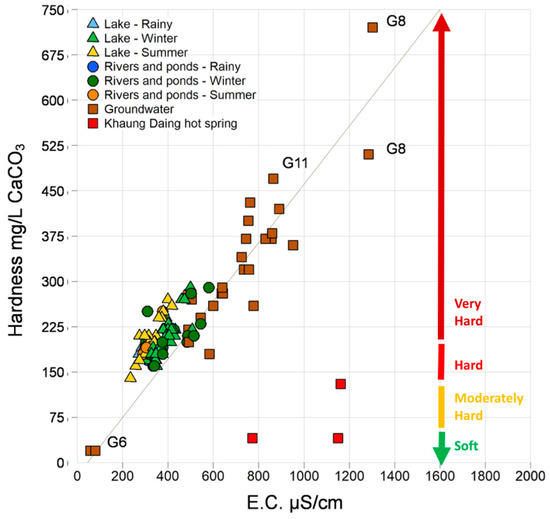
Figure 7.
Hardness (CaCO3 in mg/L) versus electrical conductivity; Water containing CaCO3 at concentrations below 60 mg/L is generally considered as soft; 60–120 mg/L, moderately hard; 120–180 mg/L, hard; and more than 180 mg/L, very hard [66].
Similarly, water scarcity is perceived as an issue in the region only by a portion of the participants (6 out of 13 respondents, answered positively to the question “Are you confronted with periods of shortage of water?”), and most of them reported that these issues are mainly evident in the summer season (April–July). In these months, some households do not get enough water for domestic purposes and irrigation (and for the latter have to use lake water instead). However, 69% of the interviewed do not think to live in a water scarce region. The reason why water scarcity is not perceived as an issue by all the respondents may be due to the fact that the region has long been water rich and also affected by flooding episodes in the rainy season (and which have been reported to increase in intensity over the years). This may affect the perception of water availability, so participants were also asked to indicate what water scarcity means to them. For most of the respondents (Figure 8a) this corresponds to “Reduction of precipitation rates”, “Less water in rivers and ponds”, and “Groundwater level decrease”. Although this information may not be representative to the whole study area, assessing how local well owners perceive scarcity is crucial, as perception shapes response to environmental changes [67,68,69,70], provides useful insights to incentivize adaptation [71], and unveils potential knowledge gaps that scientists can contribute filling through site-specific capacity building actions. For example, even if all respondents identify the temperature increase as an indicator of climate change (Figure 8b), its effect on water availability (as per the increase of evaporation and possible decrease of the open surface of the lake) does not seem obvious to the respondents. Similarly, the decrease of precipitation (“less precipitation” in Figure 8b) which is perceived as an issue associated to climate change by 92% of the respondents, is not corresponding to a similar awareness on the impact of reduced groundwater recharge (“groundwater level decrease” in Figure 8a). This may be due to the fact that the connections within the water cycle, and groundwater resources in particular, are often not well understood out of the scientific domain, and greater efforts should be made by researchers to engage in knowledge transfer.
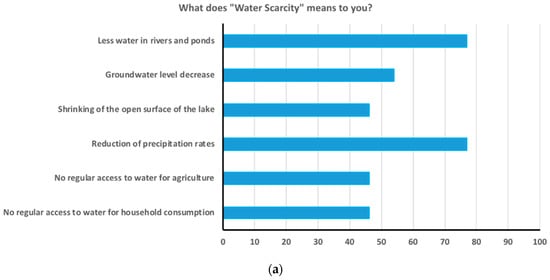
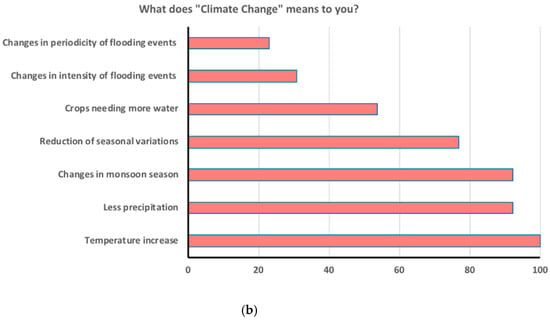
Figure 8.
Perception of (a) water scarcity and (b) climate change issues by the well owners involved in the monitoring network.
4.4. How to Translate Scientific Outcomes into Shared Actions for Groundwater Protection?
Altough all the respondents are actually the person in charge of water management in the household/community, only one, a chief of the village, considered himself having an important and active role when water protection is at stake (“What role do you think you can have in terms of water resources protection and safeguard?”:“The chief of village has a duty to clean the well (e.g., fence the well, cover the well to prevent entering leaves) and to manage the security of the well (e.g., someone can poison the well)”. For all the other respondents, it is a third party who should take charge of groundwater protection in the region: “Government and the local residents have the main responsibility for groundwater quality protection”; “State government, chief of the village and members have the main responsibility for ground water quality protection”; “The government and scientists have duty to manage the water resources”. The “free-ride” use of the commons and the perception that it is always the responsibility of others to manage and maintain the common good and the public thing, has already been analyzed [72], stressing how it is well known and unfortunately broadly implemented practice worldwide. However, it has been demonstrated that this is not the only existing approach adopted by local communities, and there are several successful examples of shared management of the environmental and water resources [73]. Thus, considering that among private well owners, they are often solely responsible for maintaining their wells [74], knowing their level of awareness and adequately shape capacity building activities may be crucial to stimulate a more proactive behaviour and the understanding of shared responsibilities towards groundwater management [75].
Getting acquainted with local perception of roles and expectations is therefore essential for supporting effective groundwater governance, to identify the priorities for capacity building [76] and to design shared science-based actions for water mangement and livelhood adaptation.
In the case of Inle lake, a scarce perception of the hydrogeological features controlling (ground)water quality emerged from the interviews. Therefore one of the priorities would be to perform outreach activities, with both the water users and local authorities (including the recently established Lake Authority), targeted to the explaination of the hydrogeological settings of the area, its relations with groundwater quality and the possible effects of climate change in the region (Figure 9). As previously mentioned, in the dry season (Figure 9a) the reduced water availablility will have severe socio-economic effects not only for the agricultural and fishing activities, but also in terms of water quality and sanitation. In fact, since the lake water volume is likely to decrease and the residence time to increase under reduced recharge conditions, the concentration, permanence, and potential sedimentation of contaminants (including nutrients, pesticides and detergents from septic effluents and wastewaters) within the lake will likely increase, with possible severe environmental and health implications. The local population should therefore be informed and instructed on how to deal with possible issues resulting from these alterations. So far, in fact, accumulation of anthropogenic contaminants and nutrients in lake waters is prevented by the short residence time [26] and the local water users may be unprepared to cope with these eventual changes. In the same way, if inundations will increase in the rainy season (Figure 9b) both residential areas and agriculturale fields in the northern and eastern parts will be increasingly subject to damages in crop poduction and infrastructures (both private and public). Also in this case, local population should be adequately informed, and shared water land management plans should be prepared in case some areas of the catchment will become uninhabitable. Additionally, future investigations should be aim to deepen the understanding of surface-groundwater interactions in view of climate changes and under different socio-economic scenarios potentially resulting in different contamination inputs.
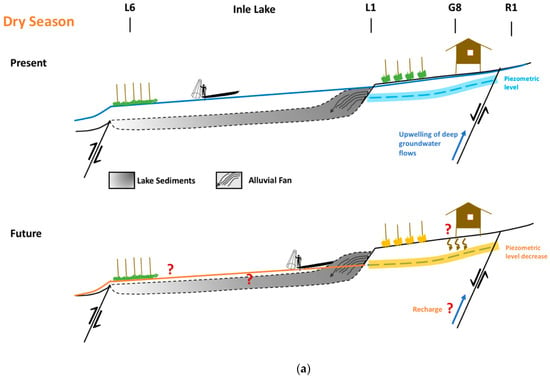
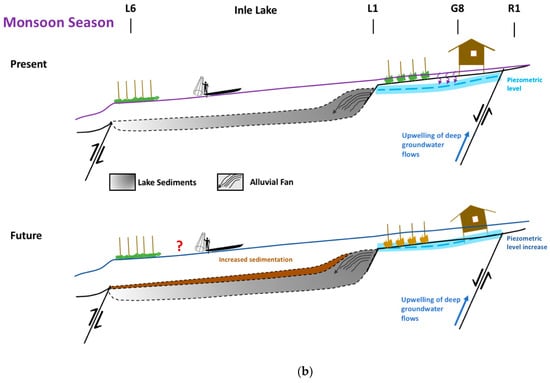
Figure 9.
Schematic representation of the possible water volume changes in the Inle Lake area in both the (a) dry season and (b) rainy season. Adapted from Ref. [28]. The red question marks indicate potential criticalities requiring further investigation.
As concerns the present water quality issues, the reason for the discrepancy between self-reported hardness and analytical results should be further investigated and it could be obviated in future studies by improving the example schemes displayed while administering the questionnaires. To raise awareness on this issue, testing the water hardness in the field together with the well owners could be performed by using water hardness strip test or, if not available, by running quick demonstration tests in the field. Additionally, future in situ assessments will foresee a discussion with local well owners to explain the hydrogeochemical results and sharing some advices on possible water uses in case potability issues emerged [77]. In particular, it will be important to raise the awareness about the possible As contamination of groundwater, which may not be always associated to other elements causing deposits or nuisances (e.g., Fe, Mn, S) and thus less evident to detect.
5. Conclusions
Understanding the social dimension of (ground)water is fundamental not only to increase the likelihood that a scientific investigation is translated into concrete actions, but also to avoid the possible exacerbation of conflicts over water use, especially in “fragile democracies”, as in the case of Myanmar. Some authors [5] stressed that, in the country, a low tradition of public participation often also results in a situation of low engagement and little faith in government initiatives. In this study case, the participation and positive feedback from the local communities to the questionnaire and subsequent discussion demonstrates that there is a clear interest and willingness to contribute to the sustainable development of the region.
Involving local communities and creating a network of trust between them and the research team is also a fundamental prerequisite for the co-creation of knowledge, which is often triggered by the need to understand whether and how the learning processes can be facilitated [8]. Additionally, understanding and assessing the relationships and co-evolution of humans and groundwater [14,78] is also reflected in sound water governance actions, since it will avoid proposing solutions not applicable to the local context due to insufficient knowledge of human behaviour [79]. In particular, with a socio-hydrogeological approach the local know-how can be fully integrated into the proposed science-based management plans, thus avoiding neglect of the role of water resources in supporting livelihood and wellbeing. In other words, by adopting a transdisciplinary approach to (ground)water resources assessment and management, it is possible to go beyond the reductionism often applied when studying natural resources [80].
Understanding the local know-how and getting acquainted with the local needs in an early stage of a hydrogeological/hydrogeochemical assessment can permit to propose and discuss solutions that are in fully respect of local sensitivities and thus more likely to be successfully implemented. For example, Götz [11] stressed that, in Myanmar, the IWRM approach at the river basin scale is starting being implemented, as for example in the Ayeyarwady Integrated River Basin Management (AIRBM; [81]) project financed by the World Bank, and it is highly encouraged by the National Water Policy (NWP; [82]). This scale, however, may not be adequate to effectively address local issues, and national norms, inspired by international framework (including the EU Water Framework Directive [83]) may not fully take into account current customary rights, as prevalent in some areas. For this reason, unveiling the social factors that underpin local groundwater governance with a socio-hydrogeological approach [84], may be an asset to effectively foster IWRM implementation taking into account both the environmental and the social-economic dimension of water resources.
Finally, engagement, even if of a small portion of the population, can promote inclusion in the debate over water resources conservation, and future assessments should be targeted to include a higher number of participants in order to avoid under-representation of some portions of the population and marginal communities. Moreover, it will be crucial to administer the structured interviews to all household members by using gender-responsive indicators. This would could unveil women’s role in water protection and help to better assess water access within each community.
Supplementary Materials
The following are available online at www.mdpi.com/article/10.3390/w13172434/s1, Table S1: hydrochemical and isotopic results of different monitoring campaigns performed in the Inle Lake catchment between 2013 and 2015 [26,27,28,35,36,37,42] compared with unpublished data collected in February 2018 (n.m. = not measured, n.d. = not detected), Text S1: Semi-structured interview form.
Author Contributions
Conceptualization, V.R. and E.S.; Methodology, V.R. and E.S.; Validation, V.R. and E.S.; Formal analysis, M.M.T. and C.T.; Investigation, E.S., V.R., M.M.T., M.M., C.T., and E.D.; Resources, E.S.; Data curation, V.R., M.M.T., C.T., and E.D.; Writing—original draft preparation, V.R. and E.S.; Writing—review and editing, C.T., M.M.T., M.M., and E.D.; Visualization, V.R. and E.S.; Supervision, E.S.; Project administration, E.S.; Funding acquisition, E.S. All authors have read and agreed to the published version of the manuscript.
Funding
The displacement to Myanmar of V.R. was supported by the Erasmus + program, KA107 International Credit Mobility, Outgoing Teaching Mobility Grants 2015–2017 managed by the University of Pavia. The University of Pavia also supported the work of V.R. through the Fondo Ricerca e Giovani (FRG) funding scheme.
Institutional Review Board Statement
Not applicable.
Informed Consent Statement
Informed consent was obtained from all subjects involved in the study.
Data Availability Statement
The data presented in this study are available in the article and in the Supplementary Materials.
Acknowledgments
Authors wish to thank all the people who have dedicated their time to the project, by answering the interviews and by allowing the team to carry out the sampling activities. We are thankful to C.S. Aung, S.N.L. Aung, and M.T.T. Zaw for the support during the 2018 fieldwork. The authors also acknowledge the analytical support of S. Comizzoli.
Conflicts of Interest
The authors declare no conflict of interest. The funders had no role in the design of the study; in the collection, analyses, or interpretation of data; in the writing of the manuscript, or in the decision to publish the results.
References
- UN Water Progress on Integrated Water Resources Management—Global Baseline for SDG Indicator 6.5. Available online: https://www.unwater.org/publications/progress-on-integrated-water-resources-management-651/ (accessed on 10 June 2021).
- United Nations. The Sustainable Development Goals Report 2019; United Nations Publication Issued by the Department of Economic and Social Affairs, 64; Available online: https://undocs.org/E/2019/68 (accessed on 26 January 2021).
- Human-Rights Based Approach to IWRM: Training Manual and Facilitator’s Guide—Stockholm International Water Institute. Available online: https://www.siwi.org/human-rights-based-approach-iwrm-training-manual-facilitators-guide/ (accessed on 26 January 2021).
- Myanmar|WaterAid US. Available online: https://www.wateraid.org/us/where-we-work/myanmar (accessed on 26 January 2021).
- Nesheim, I.; Wathne, B.M.; Ni, B.; Tun, Z.L. Myanmar: Pilot introducing the national water framework directiv. GWF Wasser Abwasser 2016, 157, 18–27. [Google Scholar]
- UN Water Country (Or Area)|SDG 6 Data. Available online: https://www.sdg6data.org/country-or-area/Myanmar (accessed on 25 January 2021).
- Lwin, K.K.; Pal, I.; Shrestha, S.; Warnitchai, P. Assessing social resilience of flood-vulnerable communities in Ayeyarwady Delta, Myanmar. Int. J. Disaster Risk Reduct. 2020, 51, 101745. [Google Scholar] [CrossRef]
- Flor, R.J.; Maat, H.; Leeuwis, C.; Singleton, G.; Gummert, M. Adaptive Research with and without a Learning Alliance in Myanmar: Differences in learning process and agenda for participatory research. NJAS Wagening. J. Life Sci. 2017, 81, 33–42. [Google Scholar] [CrossRef]
- Castelli, G.; Oo, W.M.; di Maggio, A.; Fellin, L.; Re, V.; Bresci, E. Participatory analysis of sustainable land and water management practices for integrated rural development in Myanmar. J. Water Sanit. Hyg. Dev. 2020, 11, 26–36. [Google Scholar] [CrossRef]
- Dore, J.; Lebel, L.; Molle, F. A framework for analysing transboundary water governance complexes, illustrated in the Mekong Region. J. Hydrol. 2012, 466–467, 23–36. [Google Scholar] [CrossRef]
- Götz, J.M. Contested Water Governance in Myanmar/Burma: Politics, the Peace Negotiations and the Production of Scale; Springer: Cham, Switzerland, 2019; pp. 87–106. [Google Scholar]
- Karki, S.; Thandar, A.M.; Uddin, K.; Tun, S.; Aye, W.M.; Aryal, K.; Kandel, P.; Chettri, N. Impact of land use land cover change on ecosystem services: A comparative analysis on observed data and people’s perception in Inle Lake, Myanmar. Environ. Syst. Res. 2018, 7, 25. [Google Scholar] [CrossRef] [Green Version]
- Malaysian Institute for Integrated Development. Destination Management Plan for the Inlay Lake Region 2014–2019. Ministry of Hotels and Tourism the Republic of the Union of Myanmar Destination Management Plan for the Inlay Lake Region 2. Available online: https://www.mmiid.org/publication/destination-management-plan-inlay-lake-region (accessed on 10 June 2021).
- Re, V. Incorporating the social dimension into hydrogeochemical investigations for rural development: The Bir Al-Nas approach for socio-hydrogeology. Hydrogeol. J. 2015, 23, 1293–1304. [Google Scholar] [CrossRef] [Green Version]
- Re, V. Socio-hydrogeology and Geoethics—State of the Art and Future Challenges. Adv. Sci. Technol. Innov. 2021, 373–376. [Google Scholar] [CrossRef]
- Myanmar Water Portal Hydrogeochemical and Socio-Hydrogeological Assessment of the Inle Lake Catchment (Southern Shan State Myanmar)—Myanmar Water Portal. Available online: https://www.myanmarwaterportal.com/news/2445-hydrogeochemical-and-socio-hydrogeological-assessment-of-the-inle-lake-catchment-southern-shan-state-myanmar.html (accessed on 14 June 2021).
- Michalon, M.; Gunnell, Y.; Lejot, J.; Mialhe, F.; Aung, T. Accelerated degradation of Lake Inle (Myanmar): A baseline study for environmentalists and developers. Land Degrad. Dev. 2019, 30, 928–941. [Google Scholar] [CrossRef]
- Crosetto, S.; Watkinson, I.M.; Min, S.; Gori, S.; Falcucci, E.; Le Ngal, N. Evidence of Quaternary and recent activity along the Kyaukkyan Fault, Myanmar. J. Asian Earth Sci. 2018, 156, 207–225. [Google Scholar] [CrossRef]
- Oo, T.; Hlaing, T.; Htay, N. Permian of Myanmar. J. Asian Earth Sci. 2002, 20, 683–689. [Google Scholar] [CrossRef]
- Ya, K.Z.; Otake, T.; Koide, A.; Sanematsu, K.; Sato, T. Geochemical characteristics of ores and surface waters for environmental risk assessment in the Pinpet iron deposit, southern Shan State, Myanmar. Resour. Geol. 2020, 70, 296–308. [Google Scholar] [CrossRef] [Green Version]
- Wang, Y.; Sieh, K.; Tun, S.T.; Lai, K.Y.; Myint, T. Active tectonics and earthquake potential of the Myanmar region. J. Geophys. Res. Solid Earth 2014, 119, 3767–3822. [Google Scholar] [CrossRef]
- Htwe, T.N.; Kywe, M.; Buerkert, A.; Brinkmann, K. Transformation processes in farming systems and surrounding areas of Inle Lake, Myanmar, during the last 40 years. J. Land Use Sci. 2015, 10, 205–223. [Google Scholar] [CrossRef]
- Htwe, T.N.; Brinkmann, K.; Buerkert, A. Spatio-temporal assessment of soil erosion risk in different agricultural zones of the Inle Lake region, southern Shan State, Myanmar. Environ. Monit. Assess. 2015, 187, 1–14. [Google Scholar] [CrossRef]
- Su, M.; Jassby, A.D. Inle: A large Myanmar lake in transition. Lakes Reserv. Res. Manag. 2000, 5, 49–54. [Google Scholar] [CrossRef]
- Kottek, M.; Grieser, J.; Beck, C.; Rudolf, B.; Rubel, F. World map of the Köppen-Geiger climate classification updated. Meteorol. Z. 2006, 15, 259–263. [Google Scholar] [CrossRef]
- Thin, M.M.; Sacchi, E.; Setti, M. Hydrological processes at Inle Lake (Southern Shan State, Myanmar) inferred from hydrochemical, mineralogical and isotopic data. Isoto. Environ. Health Stud. 2016, 52, 455–467. [Google Scholar] [CrossRef] [PubMed]
- Thin, M.M.; Re, V.; Sacchi, E.; Allais, E.; Thin, M.M.; Re, V.; Sacchi, E.; Allais, E. Tracing surface water dynamics and groundwater recharge at Inle Lake (Southern Shan State, Myanmar) using stable water isotopes. In Proceedings of the International Symposium on Isotope Hydrology—Advancing the Understanding of Water Cycle Processes, CN-271, Vienna, Austria, 20–24 May 2019. [Google Scholar]
- Re, V.; Thin, M.M.; Setti, M.; Comizzoli, S.; Sacchi, E. Present status and future criticalities evidenced by an integrated assessment of water resources quality at catchment scale: The case of Inle Lake (Southern Shan state, Myanmar). Appl. Geochem. 2018, 92, 82–93. [Google Scholar] [CrossRef]
- Thin, M.M.; Sacchi, E.; Setti, M.; Re, V. A Dual Source of Phosphorus to Lake Sediments Indicated by Distribution, Content, and Speciation: Inle Lake (Southern Shan State, Myanmar). Water 2020, 12, 1993. [Google Scholar] [CrossRef]
- Thin, M.M.; Setti, M.; Sacchi, E.; Re, V.; Riccardi, M.P.; Allais, E. Mineralogical and geochemical characterisation of alkaline lake sediments to trace origin, depositional processes, and anthropogenic impacts: Inle Lake (Southern Shan State, Myanmar). Environ. Earth Sci. 2020, 79, 1–18. [Google Scholar] [CrossRef]
- van Meel, P.; Leewis, M.; Tonneijck, M.; Leushuis, M.; de Groot, K.; de Jongh, I.; Laboyrie, H.; Graas, S.; Shubber, Z.; Klink, T.; et al. Myanmar Integrated Water Resources Management Strategic Study. Available online: https://docplayer.net/13558357-Myanmar-integrated-water-resources-management-strategic-study.html (accessed on 28 January 2021).
- The Myanmar Times IFC, Agriculture Department Institute GAP in Inle Lake. Available online: https://www.mmtimes.com/business/27228-ifc-agriculture-department-institute-gap-in-inle-lake.html (accessed on 29 July 2021).
- Michalon, M. Tourism(s) and the way to democracy in Myanmar. Asian J. Tour. Res. 2017, 2, 150–174. [Google Scholar] [CrossRef]
- Oo, U.M. Personal communication. 2021. [Google Scholar]
- Sacchi, E.; Re, V.; Setti, M.; Thin, M.M.; Di Sipio, E. Hydrochemical and Isotopic Features of the Khaung Daing Hot Spring (Inle lake, Southern Shan State, Myanmar). Procedia Earth Planet. Sci. 2017, 17, 750–753. [Google Scholar] [CrossRef]
- Thin, M.M. Environmental Applications of Physical Nuclear and Geochemical Techniques: Origin, Dynamics and Impact of Phosphates and Heavy Metals in Cultivated Areas and at Inle Lake, Myanmar. Ph.D. Thesis, University of Mandalay (Myanmar), Myanmar, Mainland, 2015. [Google Scholar]
- Thin, M.M.; Sacchi, E.; Setti, M. Geochemical and Mineralogical Composition of Grab and Core Sediments from Inle Lake (Southern Shan State, Myanmar). Available online: https://doi.pangaea.de/10.1594/PANGAEA.908284 (accessed on 11 June 2020).
- Johnes, P.J.; Heathwaite, A.L. A procedure for the simultaneous determination of total nitrogen and total phosphorus in freshwater samples using persulphate microwave digestion. Water Res. 1992, 26, 1281–1287. [Google Scholar] [CrossRef]
- Murphy, J.; Riley, J.P. A modified single solution method for the determination of phosphate in natural waters. Anal. Chim. Acta 1962, 27, 31–36. [Google Scholar] [CrossRef]
- Simler, R. Diagrammes: Logiciel d’Hydrochimie, Version 6.75. Available online: http://www.lha.univ-avignon.fr/LHA-Logiciels.htm (accessed on 30 August 2021).
- QGIS Development Team QGIS Geographic Information System. Open Source Geospatial Foundation Project—Version 2.2.0 2014. Available online: https://qgis.org/en/site/about/index.html (accessed on 30 August 2021).
- Sacchi, E.; Comizzoli, S.; Di Sipio, E.; Re, V.; Rotiroti, M.; Setti, M.; Thin, M.M. The Khaung Daing hot spring (Inle lake, Southern Shan State, Myanmar): Development opportunities and challenges. E3S Web Conf. 2019, 98, 09027. [Google Scholar] [CrossRef]
- OOPEC. Council directive 98/83/EC of 3 November 1998 on the quality of water intended for human consumption. Off. J. Eur. Communities 1998, 330, 32–54. [Google Scholar]
- Rozanski, K.; Araguás-Araguás, L.; Gonfiantini, R. Isotopic Patterns in Modern Global Precipitation. Geophys. Monogr. Union 2013, 1–36. [Google Scholar] [CrossRef]
- Global Network of Isotopes in Precipitation (GNIP)|IAEA. Available online: https://www.iaea.org/services/networks/gnip (accessed on 20 July 2021).
- Fritz, P.; Ian, D. Environmental Isotopes in Hydrogeology; CRC Press: Boca Raton, FL, USA, 2013; ISBN 1566702496. [Google Scholar]
- Sidle, R.C.; Ziegler, A.D.; Vogler, J.B. Contemporary changes in open water surface area of Lake Inle, Myanmar. Sustain. Sci. 2007, 2, 55–65. [Google Scholar] [CrossRef]
- Okamoto, I. Coping and Adaptation against Decreasing Fish Resources: Case Study of Fishermen in Lake Inle, Myanmar; IDE Discussion Paper; 2012; Institute of Developing Economies, Japan External Trade Organization (IDE-JETRO); Available online: https://www.ide.go.jp/English/Publish/Reports/Dp/329.html (accessed on 30 August 2021).
- Kyaw, K.T.W.; Ota, T.; Mizoue, N. Geographical Factors Trump Community Factors in Deforestation Risk in Two Watershed Conservation Forests in Myanmar. Forests 2021, 12, 541. [Google Scholar] [CrossRef]
- Biswas, S.; Vadrevu, K.P.; Mon, M.S.; Justice, C. Contemporary forest loss in Myanmar: Effect of democratic transition and subsequent timber bans on landscape structure and composition. Ambio 2021, 50, 914–928. [Google Scholar] [CrossRef]
- Supharatid, S.; Nafung, J.; Aribarg, T. Projected changes in temperature and precipitation over mainland Southeast Asia by CMIP6 models. J. Water Clim. Chang. 2021, 47, 47–69. [Google Scholar] [CrossRef]
- Shrestha, S.; Imbulana, N.; Piman, T.; Chonwattana, S.; Ninsawat, S.; Babur, M. Multimodelling approach to the assessment of climate change impacts on hydrology and river morphology in the Chindwin River Basin, Myanmar. Catena 2020, 188, 104464. [Google Scholar] [CrossRef]
- Sirisena, T.A.J.G.; Maskey, S.; Bamunawala, J.; Ranasinghe, R. Climate Change and Reservoir Impacts on 21st-Century Streamflow and Fluvial Sediment Loads in the Irrawaddy River, Myanmar. Front. Earth Sci. 2021, 9, 107. [Google Scholar] [CrossRef]
- Kreft, S.; Eckstein, D.; Dorsch, L.; Fischer, L. GLOBAL CLIMATE RISK INDEX 2016 Who Suffers Most from Extreme Weather Events? Available online: https://germanwatch.org/sites/default/files/publication/16411.pdf (accessed on 10 June 2021).
- Pradhan, N.; Habib, H.; Venkatappa, M.; Ebbers, T.; Duboz, R.; Shipin, O. Framework tool for a rapid cumulative effects assessment: Case of a prominent wetland in Myanmar. Environ. Monit. Assess. 2015, 187, 1–18. [Google Scholar] [CrossRef]
- Perrone, U.; Facchinelli, A.; Sacchi, E. Phosphorus dynamics in a small eutrophic Italian lake. Water Air Soil Pollut. 2008, 189, 335–351. [Google Scholar] [CrossRef]
- MoECAF Long Term Restoration and Conservation Plan for Inle Lake; 2014; pp. 1–138. Available online: https://unhabitat.org.mm/wp-content/uploads/2015/03/Long-Term-Restoration-Conservation-Plan-Inle-Lake.pdf (accessed on 10 June 2021).
- Abeliotis, K.; Candan, C.; Amberg, C.; Ferri, A.; Osset, M.; Owens, J.; Stamminger, R. Impact of water hardness on consumers’ perception of laundry washing result in five European countries. Int. J. Consum. Stud. 2015, 39, 60–66. [Google Scholar] [CrossRef]
- World Health Organization. Hardness in Drinking-Water: Background Document for Development of WHO Guidelines for Drinking-Water Quality; World Health Organization: Geneva, Switzerland, 2010. [Google Scholar]
- EPA United States Envoronmental Protection Agency Water Quality Criteria for Water; EPA 440/5; U.S. Environmental Protection Agency: Washington, DC, USA, 1986.
- USGS Hardness of Water. Available online: https://www.usgs.gov/special-topic/water-science-school/science/hardness-water?qt-science_center_objects=0#qt-science_center_objects (accessed on 21 July 2021).
- Pincetti-Zúniga, G.P.; Richards, L.A.; Tun, Y.M.; Aung, H.P.; Swar, A.K.; Reh, U.P.; Khaing, T.; Hlaing, M.M.; Myint, T.A.; Nwe, M.L.; et al. Major and trace (including arsenic) groundwater chemistry in central and southern Myanmar. Appl. Geochem. 2020, 115, 104535. [Google Scholar] [CrossRef]
- Miletto, M.; Pangare, V.; Thuy, L. Gender-Responsive Indicators for Water Assessment, Monitoring and Reporting Tool 1 UNESCO WWAP Toolkit on Sex-Disaggregated Water Data; UNESCO: Paris, France, 2019. [Google Scholar]
- Re, V.; Sacchi, E.; Kammoun, S.; Tringali, C.; Trabelsi, R.; Zouari, K.; Daniele, S. Integrated socio-hydrogeological approach to tackle nitrate contamination in groundwater resources. The case of Grombalia Basin (Tunisia). Sci. Total Environ. 2017, 593–594, 664–676. [Google Scholar] [CrossRef] [PubMed]
- EPA Arsenic in Drinking Water. Treatment Options. Available online: https://cfpub.epa.gov/safewater/arsenic/arsenictradeshow/arsenic.cfm?action=Treatment (accessed on 2 August 2021).
- McGowan, W. Water Processing: Residential, Commercial, Light-Industrial, 3rd ed.; Water Quality Association: Lisle, IL, USA, 2000. [Google Scholar]
- Nguyen, T.P.L.; Seddaiu, G.; Virdis, S.G.P.; Tidore, C.; Pasqui, M.; Roggero, P.P. Perceiving to learn or learning to perceive? Understanding farmers’ perceptions and adaptation to climate uncertainties. Agric. Syst. 2016, 143, 205–216. [Google Scholar] [CrossRef]
- Maddison, D. The Perception of and Adaptation to Climate Change in Africa; World Bank: Washington, DC, USA, 2007. [Google Scholar] [CrossRef]
- Musacchio, A.; Andrade, L.; O’Neill, E.; Re, V.; O’Dwyer, J.; Hynds, P.D. Planning for the health impacts of climate change: Flooding, private groundwater contamination and waterborne infection—A cross-sectional study of risk perception, experience and behaviours in the Republic of Ireland. Environ. Res. 2021, 194, 110707. [Google Scholar] [CrossRef]
- Okumah, M.; Yeboah, A.S.; Nkiaka, E.; Azerigyik, R.A. What Determines Behaviours towards Water Resources Management in a Rural Context? Results of a Quantitative Study. Resources 2019, 8, 109. [Google Scholar] [CrossRef] [Green Version]
- Singh, C.; Osbahr, H.; Dorward, P. The implications of rural perceptions of water scarcity on differential adaptation behaviour in Rajasthan, India. Reg. Environ. Chang. 2018, 18, 2417–2432. [Google Scholar] [CrossRef] [Green Version]
- Hardin, G. The Tragedy of the Commons. Science 1968, 162, 1243–1248. [Google Scholar] [CrossRef] [PubMed] [Green Version]
- Ostrom, E. Governing the Commons: The Evolution of Institutions for Collective Action; Cambridge University Press: Cambridge, UK, 1990. [Google Scholar] [CrossRef]
- Schuitema, G.; Hooks, T.; McDermott, F. Water quality perceptions and private well management: The role of perceived risks, worry and control. J. Environ. Manag. 2020, 267, 110654. [Google Scholar] [CrossRef]
- Camkin, J.; Neto, S. Roles, Rights, and Responsibilities in Water Governance: Reframing the Water Governance Debate. World Aff. 2017, 179, 82–112. [Google Scholar] [CrossRef]
- Re, V.; Misstear, B. Education and capacity development for groundwater resources management. Adv. Groundw. Gov. 2017, 215–230. [Google Scholar] [CrossRef]
- University of Pavia INTEGRON Project—Trasmissione dei Risultati. Available online: http://www-4.unipv.it/integron/index.php/coinvolgimento-del-pubblico/societa-civile/trasmissione-dei-risultati/ (accessed on 30 July 2021).
- Sivapalan, M.; Savenije, H.H.G.; Blöschl, G. Socio-hydrology: A new science of people and water. Hydrol. Process. 2012, 26, 1270–1276. [Google Scholar] [CrossRef]
- Villholth, K.G.; Conti, K.I. Groundwater governance: Rationale, definition, current state and heuristic framework. In Advances in Groundwater Governance; Villholth, K.G., Lopez-Gunn, E., Conti, K., Garrido, A., Van Der Gun, J., Eds.; CRC Press: Leiden, The Netherlands, 2018; pp. 3–31. [Google Scholar]
- Shiva, V. Staying Alive: Women, Ecology, and Development; North Atlantic Books Berkely: Berkeley, CA, USA, 1988; p. 224. [Google Scholar]
- World Bank Development Projects: Ayeyarwady Integrated River Basin Management Project—P146482. Available online: https://projects.worldbank.org/en/projects-operations/project-detail/P146482 (accessed on 30 July 2021).
- Myanmar National Water Policy. NWP National Water Resources Committee (NWRC); 2015; Available online: https://link.springer.com/chapter/10.1007/978-3-319-77440-4_6 (accessed on 3 September 2021).
- CEC Directive 2000/60/EC of the European Parliament and of the Council Establishing a Framework for the Community Action in the Field of Water Policy; Communities CoE: 2000; p. 73. Available online: https://eur-lex.europa.eu/legal-content/EN/ALL/?uri=celex%3A32000L0060 (accessed on 26 January 2021).
- Musacchio, A.; Re, V.; Mas-Pla, J.; Sacchi, E. EU Nitrates Directive, from theory to practice: Environmental effectiveness and influence of regional governance on its performance. Ambio 2019, 49, 504–516. [Google Scholar] [CrossRef] [Green Version]
Publisher’s Note: MDPI stays neutral with regard to jurisdictional claims in published maps and institutional affiliations. |
© 2021 by the authors. Licensee MDPI, Basel, Switzerland. This article is an open access article distributed under the terms and conditions of the Creative Commons Attribution (CC BY) license (https://creativecommons.org/licenses/by/4.0/).